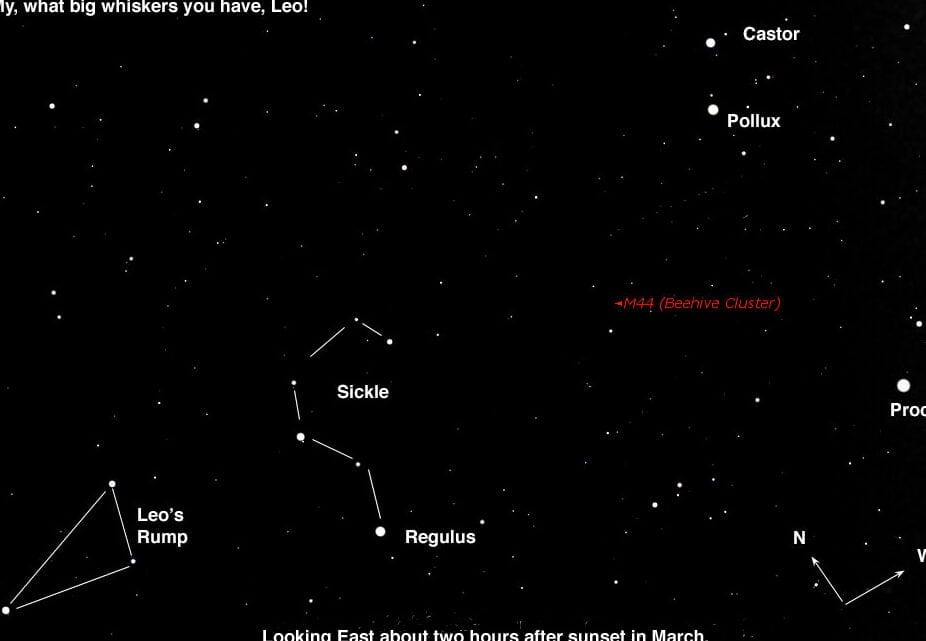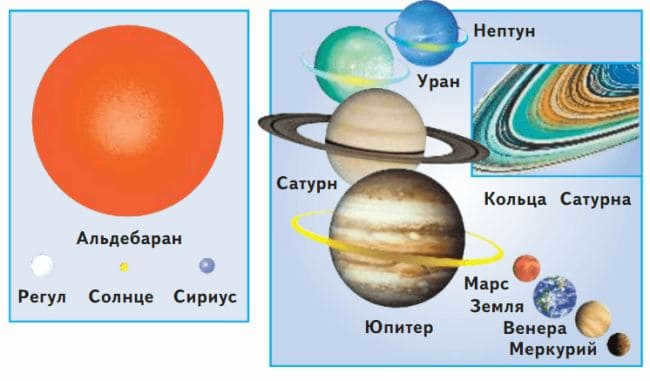
Analyze the illustration on the left side of page 58. Recall the constellations associated with the stars Regulus and Sirius. Compare the size and color of the depicted stars.
Sirius is part of the constellation known as the Big Dog. Regulus, on the other hand, belongs to the constellation Leo.
Regulus is larger in size than Sirius and it has a white color while Sirius is blue.
Let’s take a look at the atlas identifier (page 59).
Using the atlas-definator “From the Earth to the Sky,” let’s establish the guidelines for observing the celestial sky and record them in the workbook.
Guidelines for observing the celestial sky:
1) The celestial sky becomes visible above us during the evenings.
2) The sky should not be obstructed by clouds.
3) There should be no bright sources of light nearby.
4) Observe the sky without any aids.
5) To navigate the stars, it is crucial to differentiate between the northern and southern regions of the sky.
Examine the attributes of stars and planets by taking the Sun and Earth as illustrations.
Aside from their size, planets have various differences in their satellites, atmosphere, gravity, surface, temperature, and composition.
Let’s challenge ourselves (page 59)
What is the significance of the Sun for all life on Earth?
Throughout history, people have held the Sun in high regard and recognized its vital role. They understood that no living being, whether human, animal, or plant, could survive without the Sun.
Similar to other stars, it is an enormous celestial body that continuously emits light and heat. The Sun serves as the primary source of light and heat for all life on Earth.
How do stars differ from one another?
Stars vary in terms of their size, color, and brightness.
What do the other planets appear like when observed from Earth without any aid?
When observed from Earth, planets can be seen as bright stars without the aid of a telescope. However, it is important to note that unlike stars, planets do not produce their own light. Instead, they simply reflect sunlight.
- You’re here:
- Grade 3
- Surrounding World
- GDEZ answers to the textbook Environment World 3rd grade part 1, Pleshakov, Novitskaya (Perspektiva)

It may come as a surprise to you, but Regulus is not just any ordinary star in the vast sky. It is a proud member of the Leo constellation, known for its remarkable brightness. In fact, Regulus holds the esteemed title of being the Alpha star of Leo.
This celestial body is aptly named “lion’s heart,” although it is often affectionately referred to as the “star prince.”

It is interesting to note that Regulus, a star in the constellation of Leo, is classified as a star of the first magnitude despite being ranked last in terms of this characteristic. Additionally, Regulus is the brightest star located near the ecliptic.
On August 23rd of every year, the Sun is in closest proximity to Regulus, causing it to occasionally be obscured by the Moon.
Regulus is still considered a young star, estimated to be over 100 million years old according to scientists. Furthermore, the core of Leo, where Regulus is located, is approximately 3.5 times larger than the Sun in terms of mass.
Two things that never fail to astound me are the vast expanse of stars above and the unwavering moral principles that reside within us.
– Immanuel Kant
Interestingly, when observing Regulus from Earth, we have a unique perspective. This is due to two main factors. Firstly, Regulus has an axis of rotation that is aligned parallel to its direction of motion in space. Secondly, this axis is perpendicular to the line of sight from Earth, resulting in a distinct view of the star.
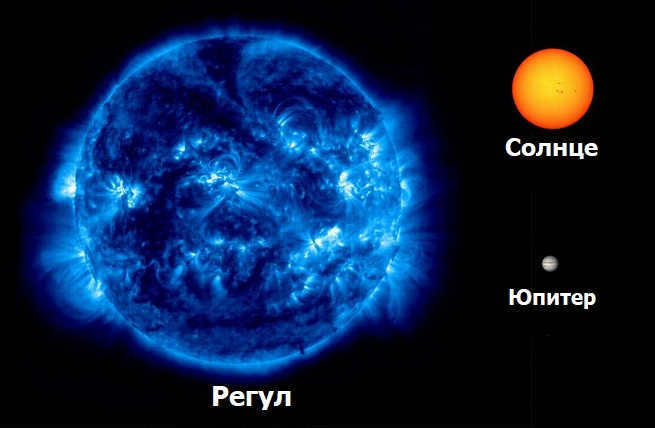
The origin of Regulus
Regulus was initially documented by Arab astronomers. Although the star had a different name in ancient Arabic texts, it was referred to as Kalb Al-Asad, which translates to “the heart of the Lion.” However, European scientists later bestowed the star with its current name. Presently, it is commonly referred to as α Leo.
The Regulus star system: a unique constellation
With its captivating complexity, the Regulus star system boasts multiple elements that set it apart. To be precise, this celestial wonder is composed of four distinct components:
First and foremost, there is Regulus A. This luminous star dazzles as a spectroscopic double star, featuring a mesmerizing blue-white main-sequence luminosity. Alongside it, a white dwarf adds an extra touch of brilliance, making Regulus A the brightest star in the entire system.
Moving on, we have Regulus B and Regulus C, a dynamic duo of main-sequence stars. While one shines as an orange dwarf, the other counterpart presents itself as a captivating red star.
As if that weren’t enough, our astute scientists have recently stumbled upon yet another celestial gem in close proximity to the Regulus star system. Dubbed Regulus D, this newly discovered dwarf star adds another layer of intrigue to an already captivating constellation.
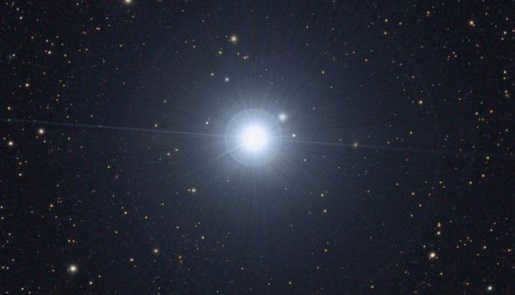
How to locate the star Regulus
In reality, finding Regulus in the night sky is not a challenging task. This is because it happens to be the brightest star in the Leo constellation. It is positioned on the outermost right side of a four-star formation.
In addition, it creates the well-known Sickle asterism. This asterism bears a resemblance to its name, as it takes the shape of an inverted question mark. Regulus is situated at the very bottom of this formation.
It is visible all year round, although the optimal time to observe it is during the winter and spring seasons.
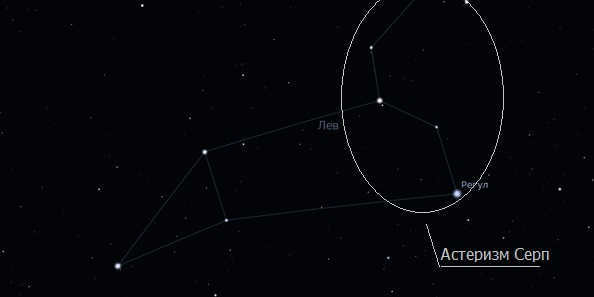
By studying the constellation, astronomers were able to identify various objects located in close proximity to the star. This discovery significantly contributed to our understanding of outer space.
Regulus is situated at a considerable distance from us (approximately 80 light years away). Despite being superior to our Sun in several aspects, such as size and mass, this star is not as bright or visible from Earth. Nevertheless, this has not dampened the curiosity of both amateurs and scientists.
- 1 The April evening sky filled with stars. A westward view
- 1.1 Venus
- 1.2 Orion and Sirius
- 1.3 The Taurus constellation and the Pleiades
- 1.4 Winter Hexagon
- 1.5 Ascendant
- 1.6 Gemini and Canis Minor
- 2.1 The Lion in the sky
- 2.2 Around the Leo constellation
- 2.3 The Big Dipper
- 3.1 Arc to Arcturus and Spica
- 3.2 Boötes, Virgo, Canes Venatici, and Coma Berenices
- 5.1 The April 2020 morning sky. Heading south
- 5.2 The April 2020 morning sky. Southeast direction
- 5.2.1 Summer triangle
April’s Evening Sky: A Glimpse of the West
As a longstanding tradition, let us begin our exploration of the night sky by turning our gaze towards the west. At this particular time, the fading glow of the evening twilight in this region imparts a magical ambiance to the scene.
So, let us embark on our celestial journey towards the west. During the month of April, the constellations of winter gracefully descend towards the horizon. Words fail to fully capture the brilliance and beauty of these celestial formations – especially when it comes to the magnificent Orion! Within the relatively compact expanse of the winter sky, one can behold the splendor of six stars that shine with the radiance of a first magnitude or even brighter. (And when Betelgeuse is at its peak, the count reaches seven!) In contrast, the vast expanse of the spring sky only boasts three truly luminous stars.
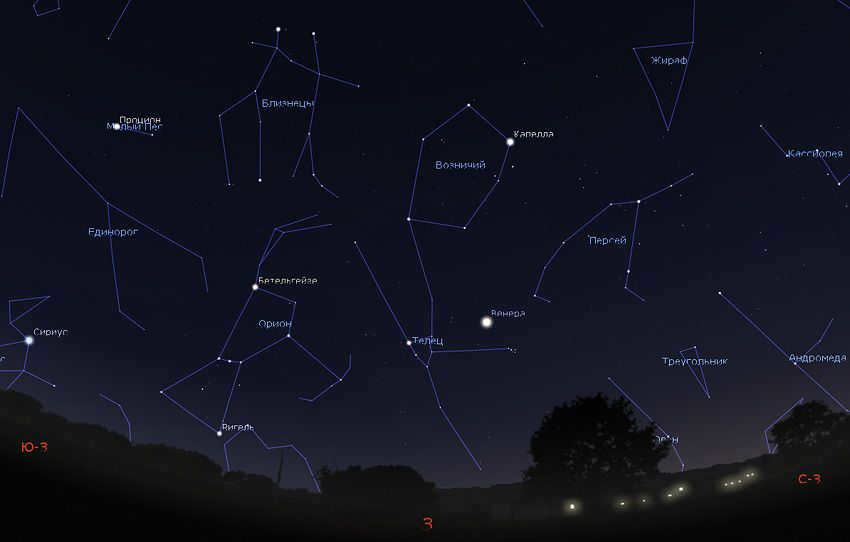
The starry sky at night during April 2020. Moving towards the west. Image: Stellarium
Venus
However, the most notable celestial object visible in the sky during April 2020 in this specific area is not a star, but rather the planet Venus!
Venus shines so brightly that it can be seen during the early hours of twilight. Once the sky darkens, it appears like a radiant beacon suspended in the heavens. In comparison, regular stars, even the most luminous ones, pale in comparison to its brilliance. (And this can be easily verified, as there are numerous bright neighboring objects near the planet!)
Orion and Sirius
The dominant winter constellation, Orion, remains visible in the southwestern sky during the early part of April. The hunter’s figure is positioned at an angle to the horizon, causing Orion’s Belt stars to appear nearly parallel to it.
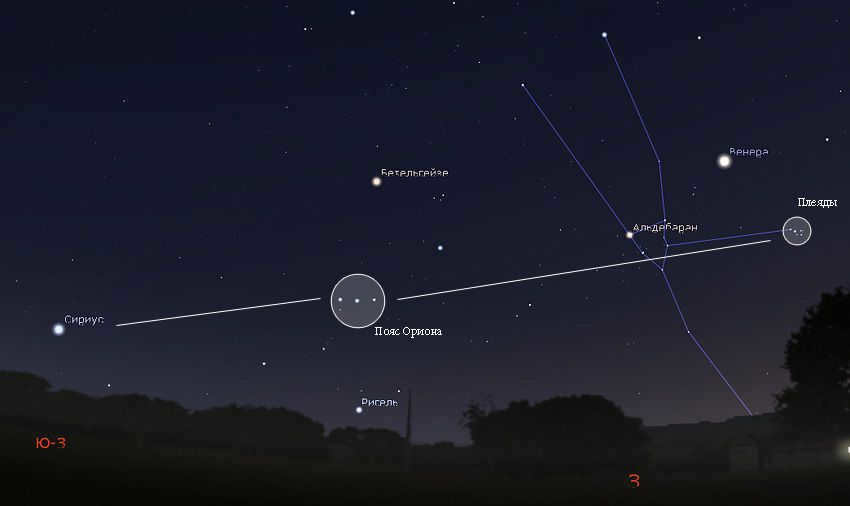
The stars located in the Belt of Orion indicate the direction of Sirius, which is the brightest star visible in the night sky, as well as the Pleiades star cluster. This information is provided by Stellarium.
Sirius, the brightest star in the night sky, can be observed to the left of Orion, appearing low above the horizon. This stellar object often displays strong twinkling and exhibits various colors, resembling the appearance of a cut diamond.
Due to its relatively low position in the sky during the month of April, locating Sirius can pose a challenge. Individuals residing north of the latitude of St. Petersburg will likely require an unobstructed view toward the western horizon. The stars comprising Orion’s Belt serve as a guide to pinpoint the position of Sirius. To do this, one must extend a line downward from the Belt stars toward the horizon.
If you extend the line connecting the stars of Orion’s Belt to the right, it will lead you to the Pleiades, a fascinating and diffuse star cluster. The Pleiades cluster resembles a tiny ladle, which can sometimes cause confusion with the Small Ladle. In ancient times, the Pleiades were considered their own constellation, but today they are part of the Taurus constellation.
In the sky during the first half of April 2020, you can locate the Pleiades by using the bright Venus as a guide. From April 2 to April 4, Venus will pass along the eastern edge of the Pleiades, moving from south to north.
The Winter Hexagon
The Winter Hexagon consists of six of the most prominent stars in the winter sky: Sirius, Rigel from the Orion constellation, and Aldebaran. This impressive asterism brings together these celestial bodies, creating a captivating sight for stargazers.
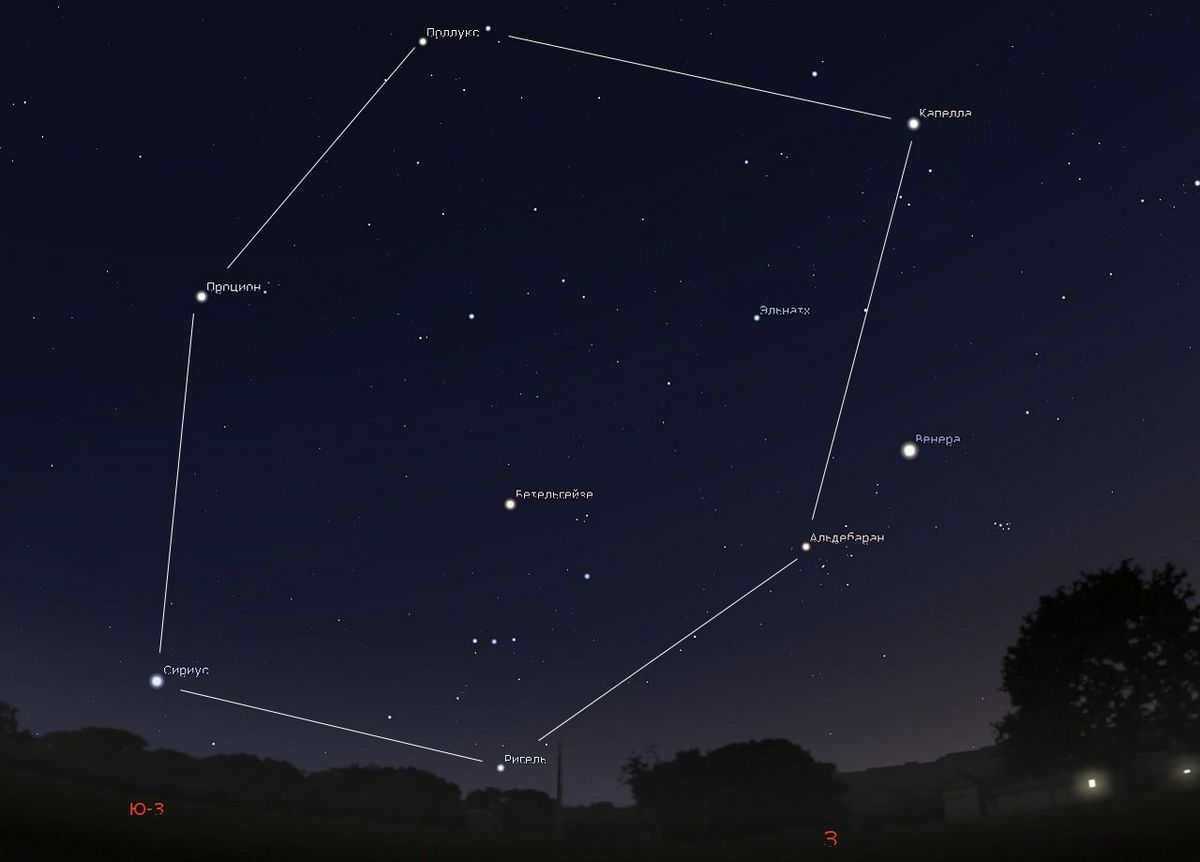
A hexagonal formation can be observed in the April sky during winter. Diagram: Stellarium
The remaining trio of stars consists of Capella from the Ascendant constellation, Pollux from Gemini, and Procyon which marks the Lesser Dog constellation. These stars can be seen much later in April compared to Rigel or Sirius. Capella and Pollux, in particular, can still be observed until dawn, serving as a beautiful reminder of the winter season.
Rising
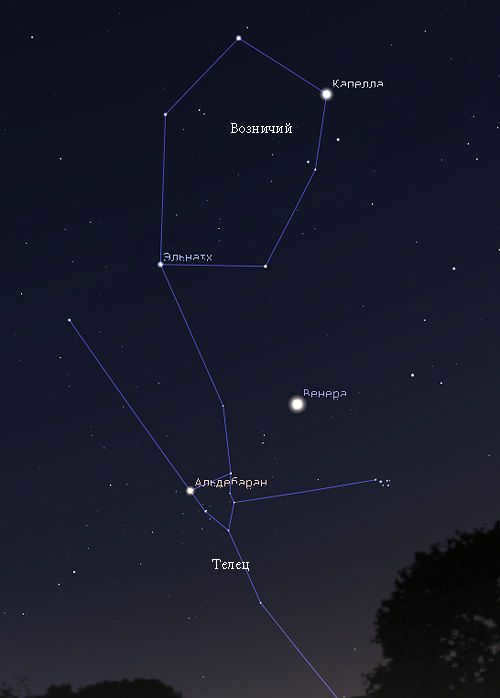
In the sky during the month of April 2020, you can observe the constellations of Ascendant and Taurus. It’s worth noting that Venus will shine much brighter than Capella, Aldebaran, and other prominent stars. The image provided is a representation from Stellarium.
If you look at the April evening sky, you will find Capella positioned above Venus. These two stars, along with two others (one of second magnitude and the other of third magnitude), form an isosceles triangle. Additionally, if we include the smaller triangle directly below Capella and another star below that triangle, we can identify the constellation known as Ascendant.
Gemini and the Canis Minor
The stars in the Gemini constellation are prominent Castor and Pollux. They can be found to the east (i.e. to the left) of Capella. During the month of April, the Gemini constellation tilts strongly towards the horizon. In this position, it is easiest to recognize two human figures standing in an embrace. However, not all the stars in the Gemini figure are bright enough to be easily observed in urban areas. For a better view of this figure, try looking at the dark country sky!
To the east of the other bright stars in the winter sky is the star Procyon. It is the main star in the small Canis Minor constellation. Besides Procyon, there is only one other noticeable star in this constellation, Gomeisa, also known as beta of the Lesser Dog. Gomeisa is located to the right and slightly above the main star in the constellation.
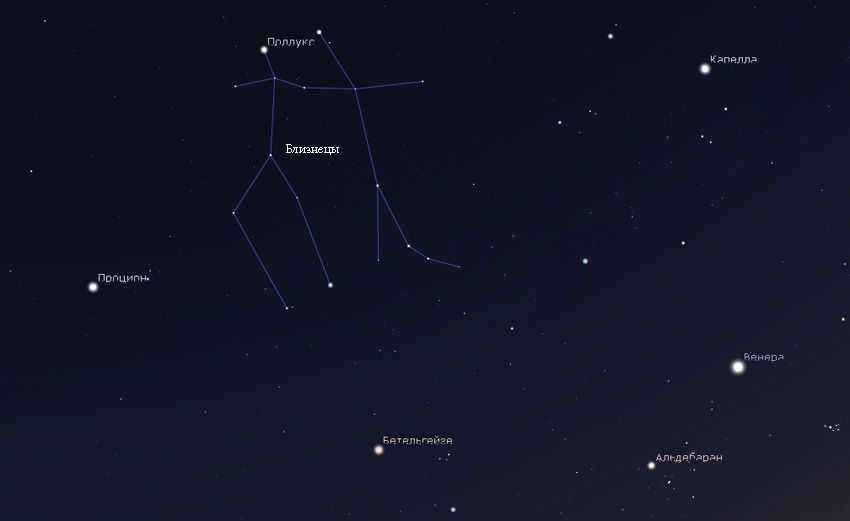
The constellation Gemini can be observed in the starry sky of April. Image: Stellarium
On the evenings of April 28 and 29, the Moon in its waxing crescent phase will move between the stars Pollux and Procyon.
As April comes to a close, only half of the Winter Hexagon will still be visible – Rigel, Sirius, and Aldebaran will set below the horizon. In just one more month, only Capella and Pollux will be left among the prominent winter stars in the night sky.
April’s Evening Sky: A Journey Southward
While the starry sky in April shines brilliantly and captivates in the western horizon, it transforms into a darker and less vibrant sight as we head towards the south! In this direction, we can only spot a single star of the highest magnitude, known as Regulus. Regulus holds the title of being the alpha star of the Leo constellation. Interestingly, it is the second brightest star after all the stars in the Winter Hexagon.
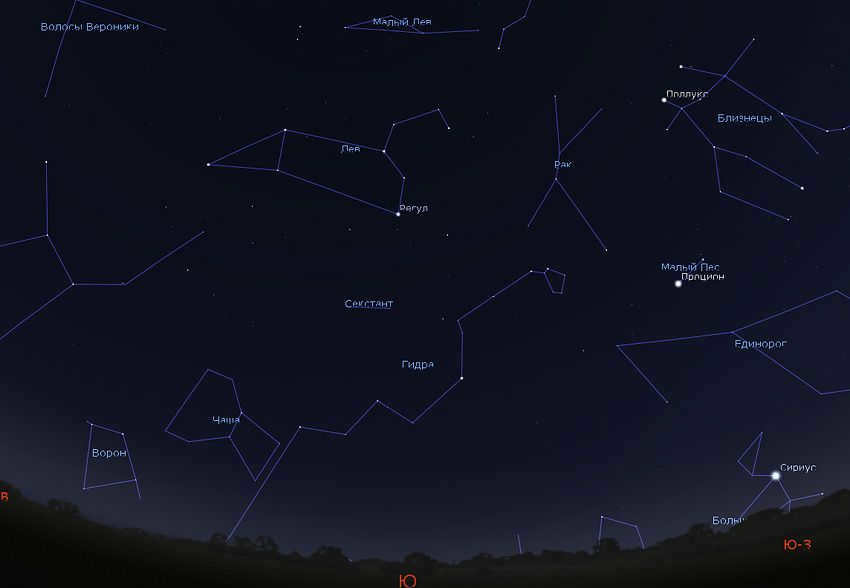
The starry sky in April. View towards the south. Image: Stellarium
The Lion in the Celestial Sphere
Regulus is part of a relatively large celestial figure that resembles a trapezoid in shape. Along with Regulus, it includes three other stars of second magnitude. Their names are as follows: Algieba (the star above Regulus), Zosma, and Denebola (the stars that form the eastern edge of the trapezoid).
This figure is known as the Leo Trapezium because all of its stars belong to the zodiac constellation Leo. On ancient maps, the trapezoid represented the lion’s body, and the three stars to the right of Algieba represented its head. It appeared as if the lion was reclining and gazing at the brilliant winter constellations.
Nowadays, the stars that make up the Lion’s head are more commonly known as part of the Sickle asterism. This celestial formation resembles an inverted question mark. The central star within this formation is Regulus.
Exploring the Leo Constellation
The Leo trapezoid serves as the prominent feature in the night sky during April. It serves as a useful point of reference when trying to locate faint and less prominent constellations that appear in the spring. Which constellations are these?
Positioned to the south of the Leo trapezoid, the elongated Hydra constellation winds its way across the sky. It holds the distinction of being the largest constellation in terms of area, yet it only contains one bright star. Alphard or Alpha Hydra can be found to the south of Regulus. When combined with Regulus and Procyon, it forms an almost perfect right-angled triangle in the heavens.

Alphard, Regulus, and Procyon create a large triangular shape in the celestial sphere. Illustration: Stellarium
Adjacent to the Hydra constellation are two faint constellations – the Cup and the Raven. These constellations have been known for at least 2500 years and hold great historical significance. In the April evening sky, they can be observed low on the horizon in the southeastern and southern directions.
The region between Regulus and Pollux is occupied by the zodiacal constellation of Cancer, also known as the Crab. This small constellation is notable for its beautiful star cluster, known as the Manger, which appears as a hazy star in the night sky.
The Great Bear
When you cast your gaze further towards the heavens, you will come across the renowned constellation known as the Great Bear. the Great Bear. During the month of April, it can be observed nearly at its highest point in the sky.
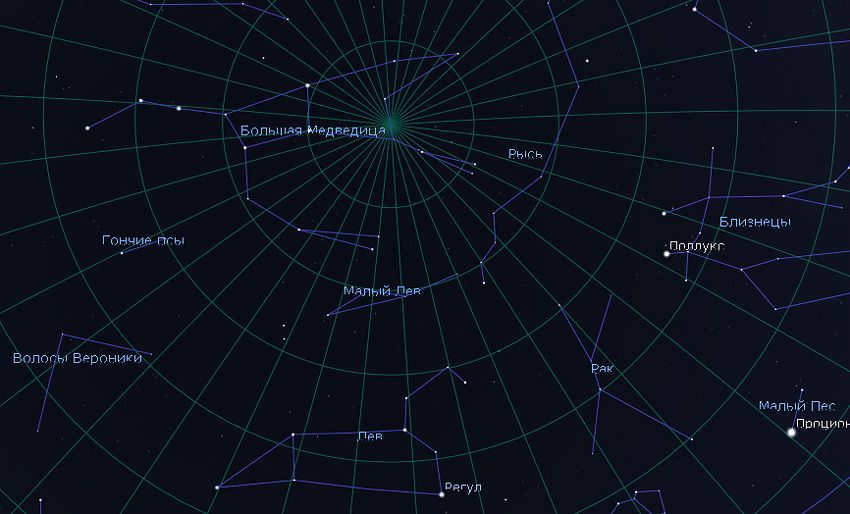
In the middle of spring, the Big Dipper can be seen almost directly above us. Image: Stellarium
The Big Dipper is made up of more than just the bucket shape that we commonly associate with it. Its stars are actually spread out, with some to the right of the bucket and others below it, extending all the way down to the trapezium of Leo.
The April 2020 Evening Sky: A View to the Southeast and East
The Path to Arcturus and Spica
Now, let’s direct our gaze towards the southeast. In this part of the sky, a brilliant star shines brightly. It is known as Arcturus, also referred to as the alpha star of the Volopassus constellation. Arcturus holds the title of being the brightest star in the northern celestial hemisphere and the fourth brightest star in the entire night sky.
Arcturus is “gazed upon” by the stars forming the handle of the Big Dipper. The handle has a curved shape, and if you continue following the arc towards the horizon, it will point you directly to Arcturus.
Extending the curved path even further, we can observe another luminous star situated low in the sky. This star is called Spica, the alpha star of the Virgo constellation.
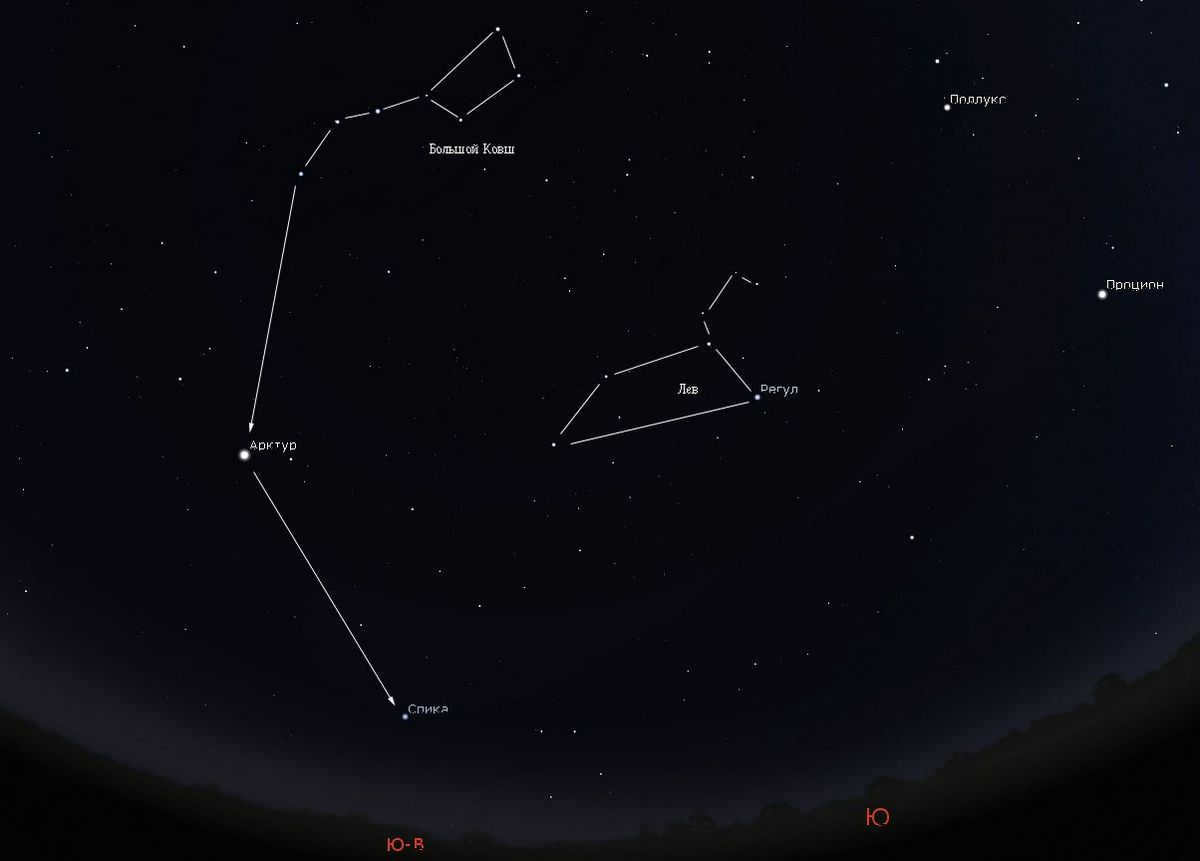
The path from the handle of the Big Dipper leads to Arcturus and then continues to Spica. Illustration: Stellarium
Regulus, Arcturus, and Spica are the trio of prominent stars in the spring sky that I pointed out earlier in this piece.
Capricorn, Virgo, Hound Dogs, and Veronica’s Hair
The star pattern known as Volopassus, which is led by Arcturus, has the appearance of a kite. Alternatively, it could be likened to a parachute mid-flight with Arcturus as the skydiver, or even an ice cream cone. During the month of April, it can be observed in the southeastern part of the sky.
Between Arcturus and the Lion’s Trapezium lies the constellation called Veronica’s Hair. Although it is quite faint, it is still worth taking the time to observe, especially when away from the bright lights of the city and when the Moon is not visible in the sky.
The two stars located below the handle of the Big Dipper form the constellation known as the Hound Dogs.
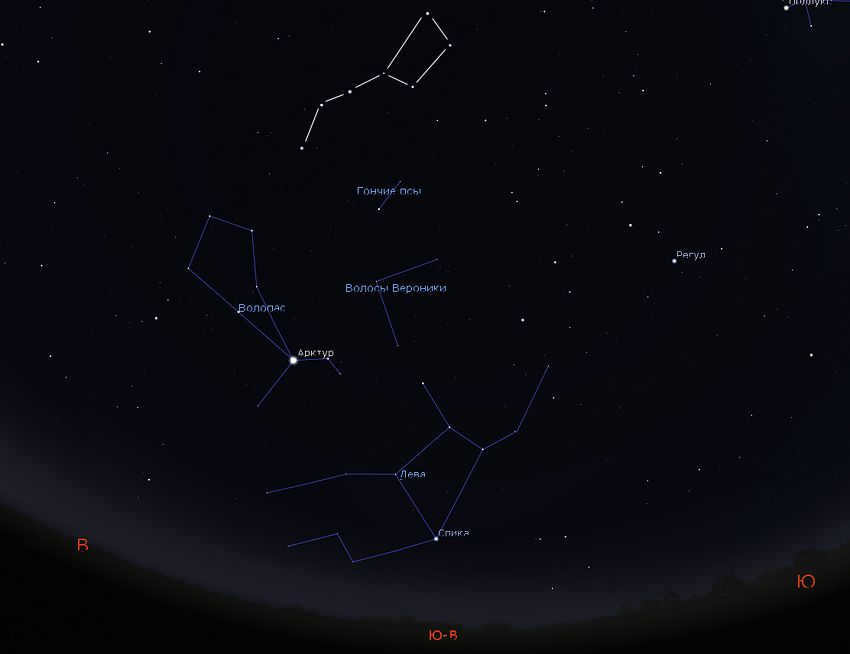
The constellations of spring can be observed in the southeast on the evening of April. See the figure below, taken from Stellarium.
One of the largest zodiacal constellations, Virgo, dominates a large area near the horizon. However, aside from the star Spica, it does not have any other bright stars. The most notable pattern in Virgo is an irregularly shaped quadrangle.
April Night Sky in the Northern Hemisphere
Now, let’s direct our gaze towards the north. During the evening hours, the celestial bodies that dominate this region of the sky are primarily the non-sunset or near-polar constellations such as Cepheus, Draco, and Ursa Minor, with Polaris serving as the guiding star. However, it is also possible to catch a glimpse of some of the summer constellations. Among them are the Northern Crown, Hercules, and Lyra.
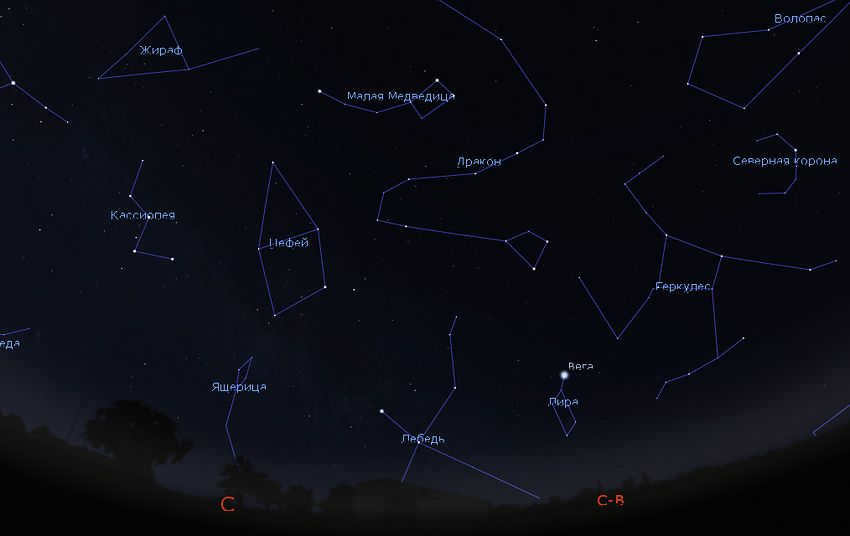
The starry sky in April, when gazing towards the north. Illustration: Stellarium
Present near the horizon, you will notice two luminous stars called Vega and Deneb. These stars are part of the Summer Triangle, which will dominate the nighttime sky from August until November.
Located towards the northwest is the constellation Cassiopeia, resembling the letter W in Latin. Furthermore, if you look even farther away, you can spot the constellation Perseus, which has a shape akin to an upside-down slingshot.
The April Morning Sky: A Shift in Constellations
In our previous discussion, we focused on the starry sky that can be seen in April 2020 during the evening and early night hours. However, what does the morning sky have in store?
Naturally, during the early morning hours of around 6-7 am, the entire celestial panorama will have shifted to the west. This shift is quite significant, approximately 90 degrees. Consequently, all the winter constellations will have descended below the horizon. In the middle zone and northern regions of Russia, only Capella will remain visible among the prominent winter stars. This brilliant luminary will twinkle faintly, lingering just above the northern horizon.
The tilted trapezoid of Leo can be spotted near the western horizon, with the Great Bucket positioned nearby. The Great Bucket also appears slanted, as if it were on the verge of spilling its contents onto the Earth!
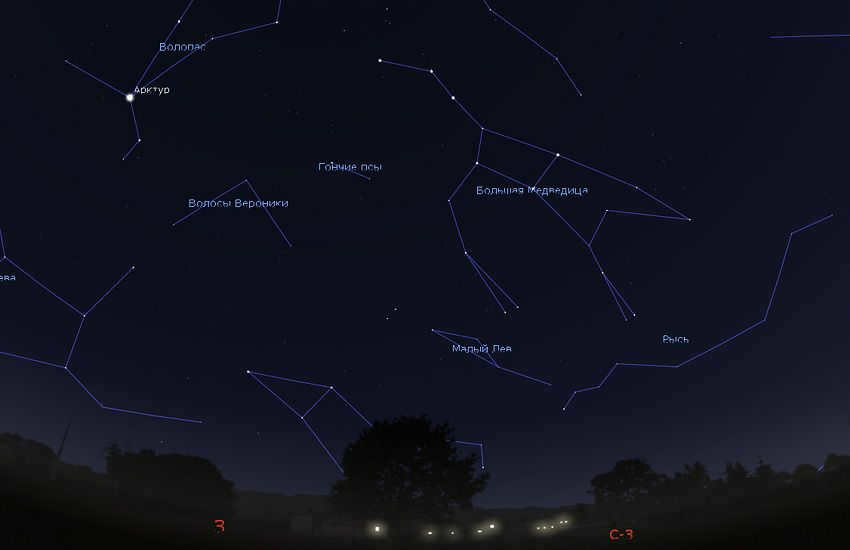
On an April morning, the sky is filled with stars. Looking towards the west and northwest, you can see a breathtaking view. In this patch of sky, two stars stand out – Arcturus and Spica. Arcturus, with its reddish hue, is the most noticeable star in this area. As you gaze to the left of Virgo and Spica, you can spot the faint constellation Libra, which hovers low above the horizon.
The April 2020 morning sky: Heading towards the south
What lies to the south? The southern hemisphere is adorned with the magnificent summer constellations including Hercules, the Northern Crown, the Serpent, and the Serpentine.
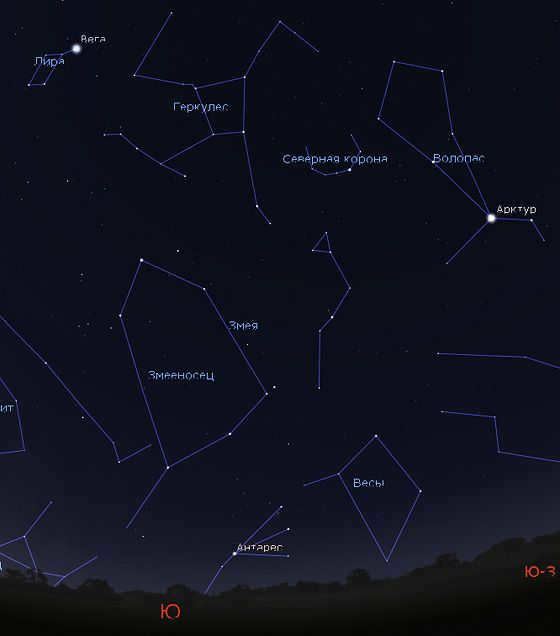
The starry sky in April 2020. Looking towards the south in the early morning. Image: Stellarium
There is a star shining brightly near the horizon. It is known as Antares, which is the main star of the Scorpius constellation and a rival to Mars in the night sky.
In temperate latitudes, only a partial view of the Scorpius constellation can be observed. In places like Moscow or St. Petersburg, there are three more relatively bright stars of Scorpius that can be seen in a fan formation to the right (west) of Antares.
The complete Scorpius constellation can only be seen in the southern regions of Russia. It should be noted that this constellation is quite distinctive, as its shape resembles that of a venomous creature.
The southeast direction in April 2020 offers a captivating morning sky
As the dawn breaks to the east of Antares, an enchanting celestial body emerges above the horizon – the magnificent planet Jupiter. In the month of April 2020, Jupiter can be found in the constellation of Sagittarius. Accompanying Jupiter are two other celestial neighbors, Mars and Saturn, although they may prove more challenging to spot due to their relatively dimmer luminosity. Fortunately, Jupiter can act as a helpful guide in locating these elusive planets. Moreover, on the mornings of April 15 and 16, the Moon will gracefully glide near these planets, further aiding in the search.
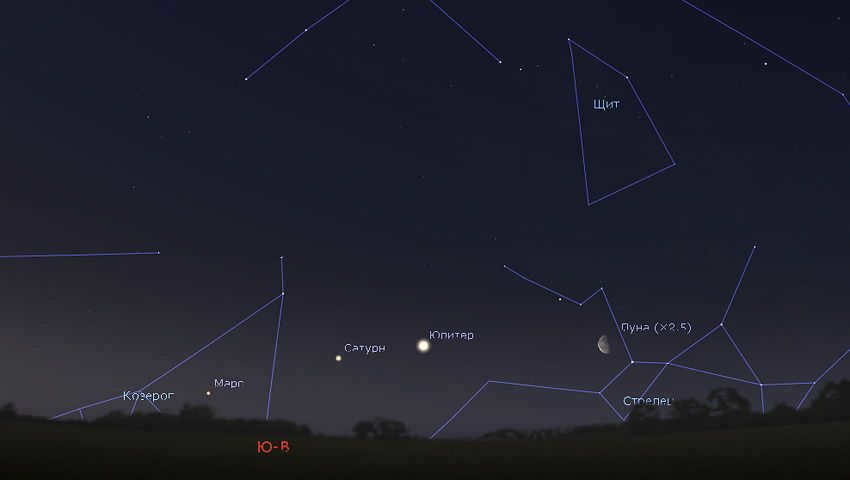
In the morning of April 14, 2020, three planets and the Moon can be observed in the sky. The height of the planets is shown for the middle zone of Russia. The image was captured using Stellarium software.
Summer Triangle
Above Jupiter, there is a prominent celestial formation known as the Summer Triangle. It consists of three bright stars that form a large triangle shape. This formation is also referred to as the Great Summer Triangle and the Summer-Fall Triangle.
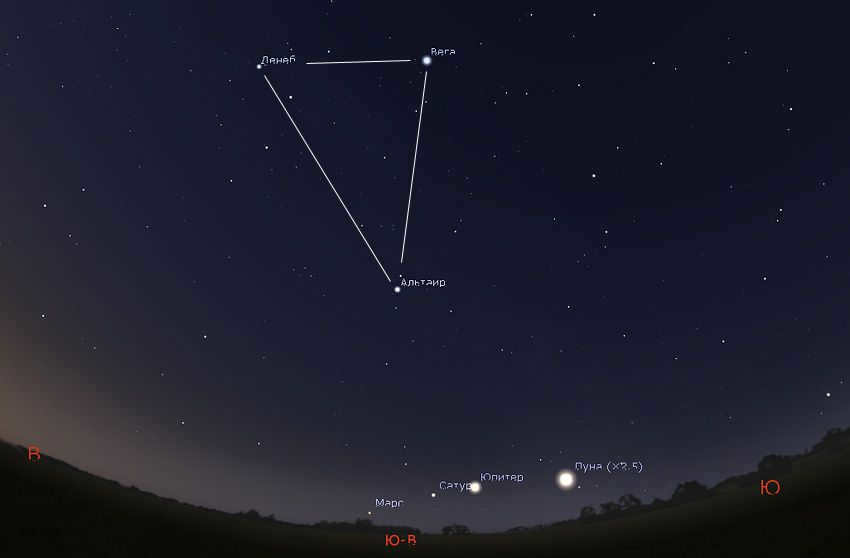
The summer triangle can be observed high above the southeastern horizon during the early morning in mid-April. Please take note that in the year 2020, the planets Jupiter, Saturn, and Mars can be found below the summer triangle. The image provided is from Stellarium.
Deneb is the brightest star in the constellation Swan, also known as Cygnus. In urban areas, it is easily noticeable that Deneb is located at the top of a cross. However, in areas with dark skies, the cross transforms into a magnificent bird with its wings gracefully spread wide. Deneb is situated in the tail of the swan, while the head is marked by the stunning double star known as Albireo.
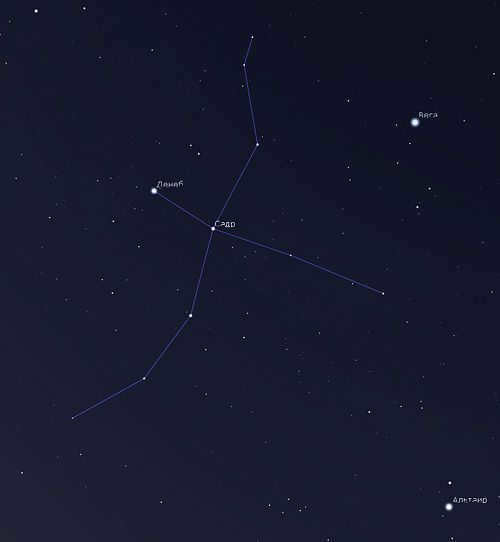
The constellation known as the Swan is depicted in the image above. This image was captured and rendered using Stellarium software, which allows users to explore and study the night sky.
It is worth noting that the constellation Eagle bears a resemblance to the Swan in terms of its pattern, but it is composed of stars that are significantly dimmer. One notable star, Altair, can be found in the tail of the Eagle.
The April 2020 morning sky, viewed in the north and east direction
Looking towards the east, one can observe the ascending constellations of autumn – Pegasus, Andromeda, and Triangle. Pegasus stands out with its prominent square shape, formed by second magnitude stars. Andromeda is attached to the eastern corner of the square, resembling a handle. (During the morning of April, this “handle” appears to be almost parallel to the horizon.) Above them, one can spot Cassiopeia, a constellation shaped like a letter W.
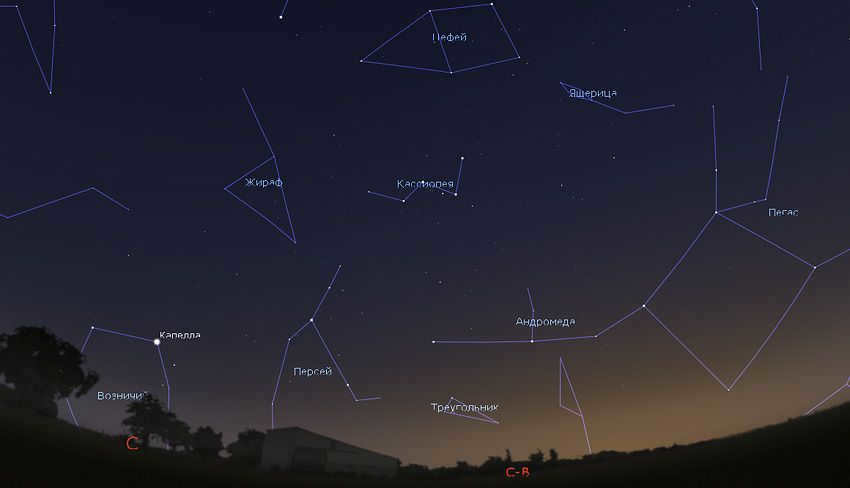
In April 2020, the sky in the morning offers a beautiful view to the north and northeast. The image shown above was captured using Stellarium.
Perseus, one of the constellations, can be seen low above the northern horizon along with the star Capella.
Summary
In April 2020, we observed the starry sky during the late evening and early morning hours, just before dawn. The constellations and their arrangements remain unchanged over time, making this description applicable to the month of March in subsequent years. However, the planets’ configurations vary. In April 2020, Venus shines brightly in the evening sky, while Mars, Jupiter, and Saturn align in the morning sky. Among these three, Jupiter stands out prominently.
It’s important to note that the arrangement of planets in the sky will differ in other years. This is worth considering if you are reading this article after 2020.
To find out more about the current positions and visibility of the planets, refer to the article “Planets in April 2020.”
You can discover here what astronomical events and phenomena are occurring in the sky during April 2020.
The most remarkable constellation in this part of the sky is Orion (Ori), which, because of its distinctive shape and position on the celestial equator, can be used as a starting point for studying this area of the sky for observers in both the Northern and Southern hemispheres. The red supergiant star Betelgeuse (? Ori), the bright white Rigel (? Ori), and the chain of three second magnitude stars that make up the belt of the mythical hunter Orion are the first things to catch the eye in this constellation. The northernmost star in this chain (? Ori) is located almost on the celestial equator. South of the belt are the “sword” stars, with the famous Orion Nebula (M 42) in the middle, which can be seen with the naked eye as a faint, irregularly shaped misty spot. Continuing the chain of stars from the Orion belt to the south, you will come across the brightest star in the sky, Sirius (a Big Dog, or ? Canis Majoris), which has a stellar magnitude of -1.4m. Continuing north along this line, slightly to the south is the orange star Aldebaran (? Taurus, or ? Tauri), which is close to the V-shaped star cluster Hyades. Further north along this line is the very prominent Pleiades star cluster, which belongs to the constellation Taurus.
The constellation Ascendant is made up of bright stars, including the star Tai, which form an irregular pentagon. On the eastern side of Capella, there is a triangle of stars known as the “Goats”. The Milky Way also passes through this constellation, although it is not as visible as in the Swan constellation or against the backdrop of bright star clusters in the Southern Hemisphere.
To the north of Orion lies the zodiacal constellation Gemini (Gemini, Gem), which is home to two notable bright stars, Castor and Pollux. Pollux, the southern star of the pair, is brighter than Castor. These two stars form the “torsos” of the twin figures and extend towards the Orion constellation. To locate Castor and Pollux, one can continue the line connecting the stars Alkaid and Mizar of the Big Dipper.
Located to the south of Castor and Pollux is the diminutive constellation known as Canis Minor (CMi), home to the brilliant star Procyon (? CMi). Procyon, along with Betelgeuse and Sirius, forms an almost perfect equilateral triangle. Positioned to the north of Procyon is another luminous star within this constellation (? CMi). Unlike Canis Minor, Canis Major (CMa), also known as the Big Dog, boasts multiple other bright stars in addition to Sirius, including the first magnitude star (? CMa).
If you extend the path of the “spine” of the Big Dog, which runs along the Milky Way, towards the star ? Korma, and then turn at a right angle through the two “triangles” of the constellation Korma (Puppis), it will lead you to the radiant Canopus (also known as a Kiel or ? Cannae), which is the second brightest star in our sky with a magnitude of -0.7. Between Canopus and Orion, you will find the constellations Dove (Columba) and Hare (Lepus).
The constellation Eridanus (Eridanus, Eri), which is named after the mythical river, begins with a third magnitude star (? Eri), located just northwest of Rigel. It then stretches far to the south with a series of faint stars (none brighter than third magnitude) and ends with Ahernar (? Eri), a first magnitude star that lies considerably to the south of Conopus.
March, April, May
Located south of the Big Dipper and in the direction of the line connecting Dubhe (? UMa) and Merak (? UMa), to the east of the constellations Gemini and Little Dog, you will find the constellation Leo. This constellation is known for its prominent pattern and is easily recognizable. The brightest star in Leo is Regulus (? Leonis), which has a magnitude of one and is positioned almost on the ecliptic. As a result, there are times when Regulus is obscured by the Moon. Regulus, along with a group of stars in Leo that stretch northwest, form an asterism that resembles a sickle or an inverted question mark. The main group of bright stars in the Leo constellation extends eastward toward the second magnitude star Denebola (? Leo).

A simple way to locate the orange star Arcturus (a Volopas, or ? Bootis), which is located much further east, is by drawing a line through Regulus and Denebola. This line runs north of the constellation of Leo and between Leo and the Big Dipper. In this area, you can also find the constellations Lynx (Lynx, Lyn) with one bright star of the third magnitude and the less impressive Leo Minor (LMi) constellation. Another small and inconspicuous constellation, Cancer (Cancer, Cnc), is located between Gemini and Leo. Within Cancer, you can find the prominent scattered star cluster Crèche (Praesepe, M44).
Located south of the Cancer constellation and east of Procyon (? CMi) is the small asterism known as the “head” of Hydra. Hydra (Hydra, Hya) is the largest constellation in the sky, but surprisingly it only has one bright star, Alpharad (? Nua), which can be found to the south of Regulus. (The “head” of Hydra and Alpharad are indicated by the line connecting Castor and Polux.) Extending from the “head” is a chain of faint stars in Hydra’s tail that first moves southward and then eastward, running almost parallel to the celestial equator, and eventually ending to the east of Arcturus.
To the north of Hydra, there are three less noticeable constellations. The most unremarkable of these is Sextans, which has stars fainter than 4.5m and is located south of Regulus and northeast of Alpharad. Another constellation, Crater, can be found northwest of Hydra, and to the west of Hydra is a prominent group of quadrangular stars that form the constellation Corvus.
Within this portion of the celestial sphere, there exists a noteworthy assemblage of stars referred to as the “False Cross”. This particular ensemble includes stars originating from two constellations, Sail (Vela, Vel) and Kiel (Carina, Car). One arm of this “Cross”, which is composed of ? Sag and ? Vel, guides the observer’s gaze towards the extraordinary binary star ? Vel, situated in the northern region, and continues further to ? Stern. The other arm of the “Cross” is comprised of the prominent first magnitude stars ? Sails and the orange-hued ? Sails, both positioned to the north.
May, June, July
The months of May, June, and July
Spring turns into summer during the months of May, June, and July
As spring comes to an end, May, June, and July mark the beginning of summer
During the months of May, June, and July, the weather becomes warmer and the days get longer
Although the Southern Hemisphere is home to the brightest stars Sirius, Canopus, and ? Centauri, the fourth brightest star, Arcturus (? Woo), can be found in the easily visible constellation of Magpies (Bootes, Boo). Arcturus has a stellar magnitude of 0.0m. To locate Arcturus, simply continue about 30° downward toward the equator along the slightly curved line that connects the two outermost stars of the Big Dipper’s tail. The constellation Volopassus is notable for its arrangement of relatively bright stars that form a P-shape north and east of Arcturus. Among these stars, the brightest is Itzar (? Woo), which is a well-studied double star. Following the same line, we reach Spica (? Virgo), which is situated slightly south of the ecliptic. Continuing along the arc, we encounter the four principal stars of the Raven constellation (Corvus, Crv). The constellation Virgo (Virgo, Vir) is quite large and stretches out on either side of the celestial equator. Aside from Spica, Virgo does not contain any stars brighter than the third magnitude. Directly south of Denebola (? Leo) lies (? Vir), and the constellation Virgo itself is easy to spot due to a group of third and fourth magnitude stars arranged in the shape of a quadrangle below and east of Arcturus.
In the northern part of the sky, you can see the solitary bright star of the small constellation Hound Dogs (Canes Venatici, CVn). It is positioned in the center of the arc created by the “tail” of the Big Dipper. Moving towards the south, there is the dim constellation Hair of Veronica (Coma Berenices, Com), which, similar to the Virgo constellation, contains numerous distant galaxies.
Heading east from Volopassus, you will encounter a nearly perfect circle of stars that forms the Northern Crown constellation (Corona Borealis, CgB). This highly noticeable constellation is home to the first magnitude star Gemma (? CgV) and the fascinating variable star R of the Northern Corona. Traveling southwards, you will come across a disrupted line of stars that makes up the “head” of the Serpens Caput, a part of the Serpens constellation.
To the north of the Southern Cross and two prominent stars – Alpha and Beta Centauri – lie other bright stars of the same constellation. These stars form a pentagon-shaped pattern that is located south of the “tail” of Hydra. In this section of the Hydra constellation, there are only two relatively bright stars and the variable star R Hya, whose brightness occasionally surpasses the fourth magnitude. Nearby, in the Centaurus constellation, you can find one of the brightest globular clusters visible in our night sky – Omega Centauri. East of the Centaurus constellation, there is the irregular and slightly rectangular-shaped constellation of Lupus (the Wolf), whose stars are not brighter than the third magnitude. This constellation extends towards the brilliant red star Antares (Alpha Scorpii), which is the most prominent star in this particular area of the sky.
July, August, September
During this period in the northern part of the sky, the “Summer Triangle” constellation composed of Vega (in Lyra), Deneb (in Cygnus), and Altair (in Aquila) is particularly noticeable. In the southern hemisphere, the constellations Scorpius and Sagittarius (Sagittarius, Sgr) dominate the sky, with the brightest section of the Milky Way passing through them. One remarkable feature is the prominent cross-shaped constellation Cygnus (Cyg) which contains the telescopic double star Albireo (in Cygnus). A line connecting Deneb and Albireo points southward, leading to the “Great Gap” in the Milky Way. Just south of the “Great Gap” lies the constellation Aquila (Aql), which has a distinctive “T” shape.
The small group of stars known as Lyra (Lyr) is made up of the bright star Vega and a collection of faint stars forming a “parallelogram” shape in the southeastern sky. Just slightly to the north and east of Vega lies the well-known “double” star system known as Lyr, which can be easily seen without a telescope. When viewed through a telescope, each star in the system appears to split into two separate stars. Moving westward between Lyr and the constellation Northern Crown, you will come across four stars forming a shape known as the “Wedge.” This grouping is actually part of the larger constellation Hercules (Her), which is characterized by its “arms” and “legs” extending from the corners of the “Wedge.” Within the Wedge, there is a cluster of stars known as ?13, which can only be seen as a hazy spot with the naked eye. One notable star within Lyra is the third magnitude star Ras-Algeti (? Her), which is located in the southern part of the constellation’s “head.” Ras-Algeti is a binary star system, with one of its components being variable in brightness. This star is in close proximity to the brighter star ? Serpens (Ras-Alhage).
The Serpentine constellation (also known as Ophiuchus or Oph) is shaped like a pentagon and can be seen across the equator and ecliptic. It separates the stars in the Serpent constellation into a “head” (to the west) and a “tail” (to the east).
Scorpius, with its red star Antares and a line of bright stars extending into the Milky Way, forms the prominent southern constellation known as the “Torso”. The “pincers” of Scorpio now make up the constellation Libra (also spelled Lybra), which is located to the west.
The majority of the stars in the Sagittarius constellation are also located in the Milky Way, to the east of Antares. This is where the center of our Galaxy can be found. It can be quite challenging to distinguish this constellation, except for the central part known as the Teapot. To the south is the Southern Corona constellation (Corona Australis), which is not as prominent or noticeable as the Northern Corona. Further south is the faint constellation Telescopium.
The Scutum constellation, which is barely distinguishable, along with the Wild Duke cluster (M11), can be found in the center of the Milky Way between Sagittarius and Eagle. Moving north between Eagle and Swan is the small Sagitta constellation and the slightly larger Vulpecula constellation. To the east, there is a rather prominent small group of stars in the Dolphin constellation (Delphinus).
September, October, November
The months of September, October, and November.
If you continue tracing the path along the southeastern “wing” of the Swan constellation, it will lead you to Markab (? Pegasus), which is one of the four stars that make up the “Great Square of Pegasus”. In reality, this square appears more like a slightly tilted rectangle, with its shortest side running directly from north to south. (If you were to extend the line connecting ? and ? of the Big Dipper through the celestial pole, it would pass through ? and ? of Pegasus.) Interestingly, the star located in the northeast corner of the “Big Square of Pegasus” actually belongs to the Andromeda constellation. It is known as ? Andromeda (Alferrats). The remaining stars in the square are part of the Pegasus constellation (Peg). The brightest star in Pegasus, ? Pegasus, can be found halfway between Markab (? Peg) and Altair (? Aql). Situated between ? Peg and the Milky Way are two other constellations: the Lesser Horse (Equuleus), which is quite small, and the more prominent Dolphin (Delphinus).
To the south, you can find the constellation Southern Fish (Piscis Austrinus, PsA) which includes the prominent star Fomalgaut (? PsA). Among the group of bright stars in this constellation are ? PsA, ?, ?, ? and ? which, when observed in the sky, form a quadrilateral shape resembling a kite. The last two stars align with ? Indian, which is located to the west. Between this star and the southern part of the Capricorn constellation lies the smaller and less noticeable constellation Microscopium. The two brightest stars in Microscopium, ?, and ?, have a magnitude just above fifth. Towards the east of Fomalgaut, you can find another faint constellation called Sculptor (Scl). The brightest star in Sculptor, ? Scl, has a slightly higher stellar magnitude of 4.5m.
November, December, January
The months of November, December, and January are the last three months of the year.
Stretching from the top of the “Great Square of Pegasus” towards the northeast, there is a noticeable chain of bright stars that make up the “body” of Andromeda (Andromeda, And) – ?, ? and ? And – ? Per and at a significant distance – Capella (? Aur). Starting from ? And, there is a line formed by two faint stars that points towards the constellation Cassiopeia; the second star, ? And, is located near the Andromeda Nebula (M31), which appears as a blurry spot when seen with the naked eye. Moving further south, in the constellation Triangulum, there is another massive spiral galaxy known as MZZ. Some stargazers claim that under very dark skies and optimal conditions, it is possible to see MZZ with the naked eye. However, MZZ is more easily visible with binoculars and can be quite challenging to observe in small refractor telescopes due to its large size and low surface brightness.
The shape of the constellation Perseus (Perseus, Per) is not easily defined. A continuous chain of stars starts at ? Per and extends in a northwesterly direction through ?, ? and ? Per. The famous double cluster of stars h and ? Perseus can be seen with the naked eye, and it is located about halfway between ? Per and ? Cas. To the south of ? Per, there is a short line of stars that bends slightly to the east, leading to the well-known eclipsing variable star Algol (? Per) and another variable star, ? Per. Another line of stars starts at ? Cas and goes southward, curving slightly to the east, until it reaches the third magnitude star ? Per, which is positioned above the Pleiades cluster.
Regulus, also known as Alpha Leo, is the most brilliant star in the vast constellation Leo, which can be found in the Northern Hemisphere. It holds the 21st position on the list of the most luminous stars in the celestial sphere. The optimal time to observe Regulus is during the spring months, particularly in March and April, when the sky is not overly populated with stars. However, during the summer season, its visibility is often hindered by the Moon due to its close proximity to the ecliptic line.
Alpha Leo is classified as a hot blue-white star, possessing a visual magnitude of -1.35 and located approximately 80 light years away from Earth. Consequently, it may appear less bright than other stars, despite its mass surpassing that of the Sun by 3.5 times, its radius being nearly 4 times greater, and its luminosity exceeding the Sun’s by over 140 times.
Engrossing details regarding the celestial body
The star known as Regulus possesses an intriguing feature as it is a part of a triple star system, accompanied by two smaller companions. Over a span of approximately 130,000 years, these celestial bodies complete a full revolution around Alpha Leo.
Regulus exhibits an atypical structure, resembling a flattened ellipsoid, wherein the pole region is half as hot as the equator and emits a significantly higher amount of light. This astral entity rotates at such a remarkable velocity that it completes a full revolution around its axis within a mere 16 hours. Should the star experience even a slight increase in its rotational speed, it would be unable to sustain itself and would ultimately collapse.
Alpha Leo was once thought to be a youthful star, with an estimated age of no more than 100 million years. However, in 2008, a dwarf star was found near Regulus, sparking a new theory that Alpha Leo is actually much older, around 900 million years. Not only does it actively burn its own hydrogen reserves, but it also pulls hydrogen from neighboring stars.
If you want to find Regulus in the virtual universe, you can make a special gift for your loved ones. This shining star will serve as a guiding light on their life journey and a precious talisman.
Regulus (α Leo, α Leo, Alpha Leo, Regulus, Alpha Leonis, α Leonis, Alpha Leo) is the most brilliant star in the Leo constellation. Regulus ranks as the 21st most brilliant star in the night sky. It can be found at a distance of 78 light-years away from our Sun. This regal star possesses a spectral type B7V and boasts a surface temperature of 10,000° C. Its luminosity is 150 times greater than that of the Sun. With a mass of 3.5 solar masses, Regulus has a diameter 3.2 times larger than our Sun.
The name Regulus (Alpha Leo) is derived from the Latin word meaning “prince” or “little king.”
There exists a system with a four-star configuration, including two sets of double stars, alongside a primary star. Regulus A, which is a blue-white star on the main sequence, is accompanied by a white dwarf that has yet to be directly observed, but is believed to have a mass equivalent to 0.3 solar masses. These two stars revolve around their shared center of mass in approximately 40 days. However, their proximity is such that their individual colors can only be distinguished through spectroscopic analysis.
The binary pair, consisting of two dwarfs (one orange and one red), is situated at a distance of around 4,200 astronomical units (a.u.) from Regulus. The orbital period, which is the time it takes for one celestial body to complete one revolution around another, is estimated to be about 130,000 years. The separation between the two dwarfs is roughly 95 a.u., which is more than three times the average distance between Neptune and the Sun.
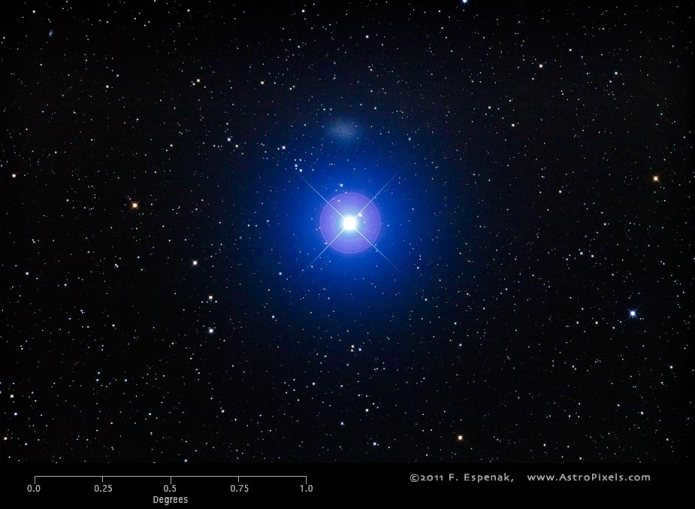
Regulus’ position in the celestial sphere
Alpha Leo is visible from latitudes ranging from +90 to -65 degrees. To locate the constellation, one should follow the pointer stars of the Big Dipper in the opposite direction of Polaris. Regulus, which represents the heart of Leo, is situated at the bottom of the constellation. This star is most prominent in the late winter and spring seasons for observers in the northern hemisphere.
A study published in 2005 analyzed the motion of Regulus and revealed that a slight increase in its rotational speed by about 10 percent would cause it to explode into fragments. The rotation speed of Alpha Leo, also known as Regulus, is approximately 1.1 million km/h at the equator, significantly faster than the Sun’s rotation speed of about 7242 km/h. The effects of rotation on Regulus were first explored in a 2005 study conducted using the CHARA telescope array situated on Mount Wilson in California. Interestingly, the temperatures on Regulus vary significantly, with the poles reaching around 15,100°C and the equator measuring about 10,000°C. This temperature difference is attributed to the star’s distorted shape, which reduces gravity and subsequently lowers the temperature at the equator.
The historical significance of Regulus
Throughout the course of history, Regulus has held great importance and has been closely linked to royalty. The ancient Babylonians referred to this star as Sharru, which translates to “king”. Similarly, the Persians regarded Alpha Leo as Miyan, meaning “center”, and it was recognized as one of the four esteemed “royal stars”. In ancient India, Regulus was known as Magha, signifying its might and power. The renowned Greek astronomer Ptolemy chose to describe this star as Basilisk, which can be interpreted as “little king”. This name was later translated into Latin as Regulus by Nicolaus Copernicus.
In medieval Europe, Regulus was also recognized by astrologers as one of the fifteen Begnian stars, which were believed to possess mystical properties. In the case of Regulus, its magical qualities were associated with granite. The connection between this star and the majestic properties of granite further enhanced its significance in the eyes of astrologers during the medieval period.
When you gaze up at the sky on a spring night, you can easily spot three prominent stars – Arcturus, Spica, and Regulus. These stars shine brighter than any others and capture the attention of even those who aren’t well-versed in astronomy.
Regulus: The Starry Sky’s Prince
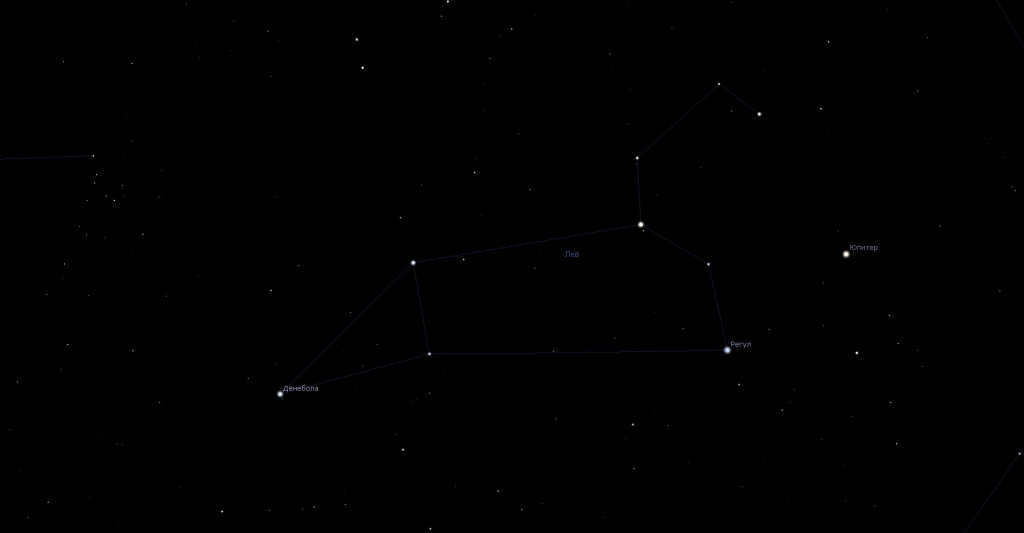
Regulus, also known as the alpha star of the Leo constellation, is one of the most prominent stars in the night sky. It is particularly visible during the spring season when the sky is less crowded with other bright stars compared to the summer months. However, observing Regulus in the summer can be challenging due to its proximity to the ecliptic, which sometimes leads to its temporary obscuration by the Moon.
Resources on the subject
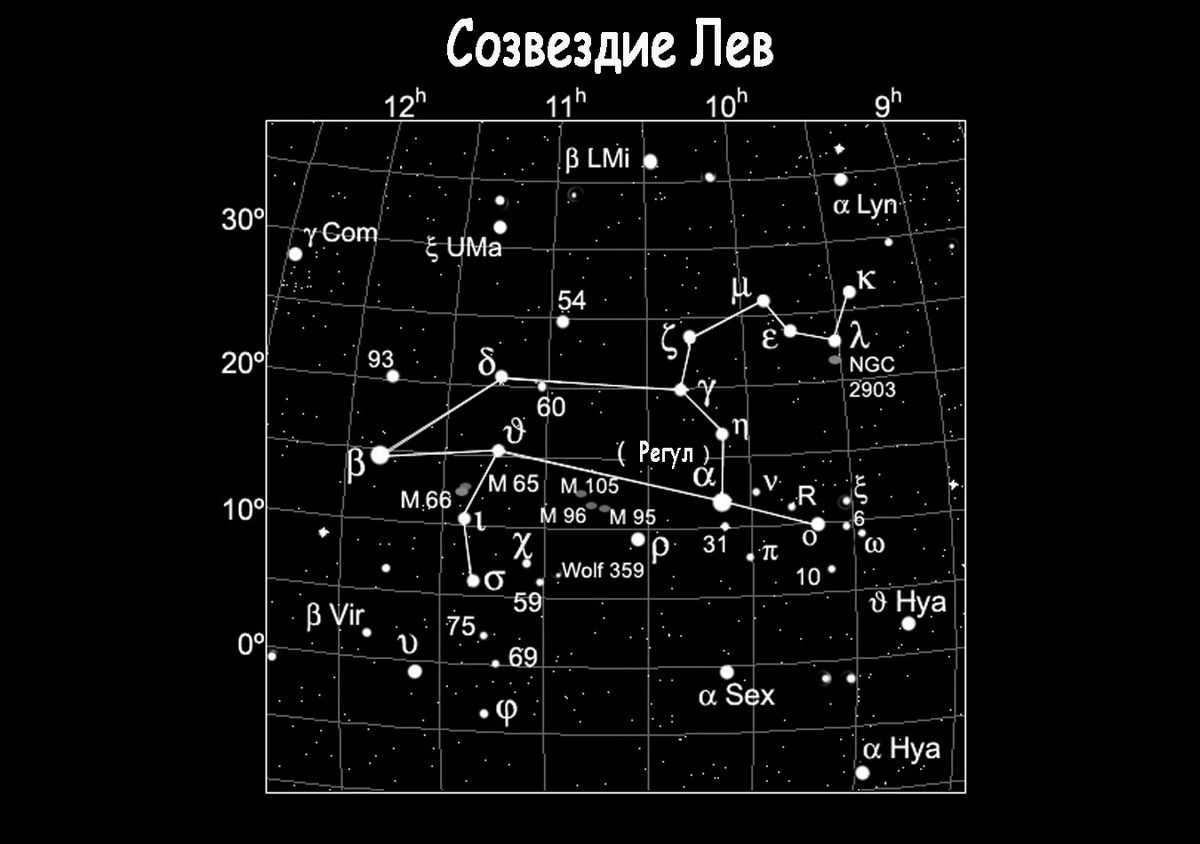
However, during the spring season, Regulus can be easily spotted among the numerous stars, even without the aid of a telescope, because it is located far from the ecliptic line and shines with extraordinary brightness.
Etymology and Discovery
Anomalous Shape and Rapid Rotation of the Star
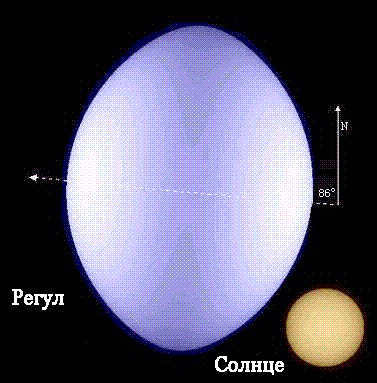
The star Regulus is of great interest to amateur astronomers due to its exceptional brightness and unique shape. Unlike our Sun, Regulus rotates at an incredibly fast speed of 315 km/s, which is 150 times faster. This rapid rotation causes the star to have a flattened shape, with its equatorial radius being almost 1/3 larger than its polar radius. The star completes one full rotation on its axis in less than 16 hours.
What makes Regulus even more intriguing is that if its rotation rate were just 14 percent higher, at 359.1 km/s, the centripetal gravitational force would not be sufficient to maintain its structural integrity, resulting in its collapse.
Regulus, unlike the majority of stars, has a tilted axis of rotation, resulting in our observation of this celestial body from a unique angle. The star’s rapid rotation speed causes its pole region to be approximately half as hot as its equator and five times brighter. Interestingly, Regulus’ axis of rotation aligns with its orbital path, causing the star to appear as if it is moving on its side along its orbit. This astronomical phenomenon is truly fascinating.
Weight and years
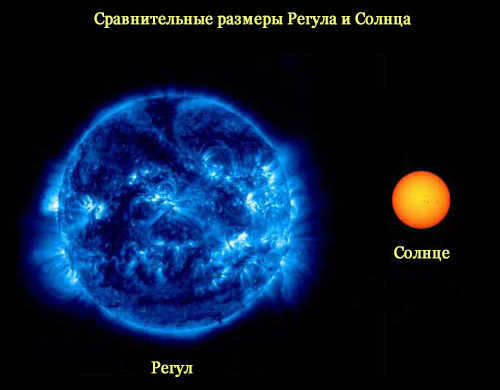
Comparison of the Sizes of Regulus and the Sun
According to the calculations made by modern physicists and astronomers, it has been determined that Regulus is a considerably massive star. The consensus among scientists is that Regulus has a mass that is three and a half times that of the Sun.
Regarding the age of Regulus, scientists have not always held unanimous opinions. In the past, it was believed that Regulus was no more than 100 million years old, which would classify it as a young star. However, in 2008, scientists discovered a dwarf star called Regulus D in close proximity to Regulus. This finding led scientists to speculate that Regulus is actually much older than previously believed.
How to identify Regulus in the night sky
Regulus, also known as Alpha Leo, stands out as the most brilliant star in the constellation of Leo and ranks as the 21st brightest star in the entire sky. It possesses an apparent magnitude of 1.35 and resides at a distance of 79.3 light years. However, what we perceive as a single star is actually a complete system.
The primary component of Regulus is Regulus A, which is a spectroscopic binary star consisting of a blue-white main-sequence star classified as B7 V and a white dwarf. The visual magnitude of Regulus A is 1.35, and it is responsible for the blue hue observed in the system.
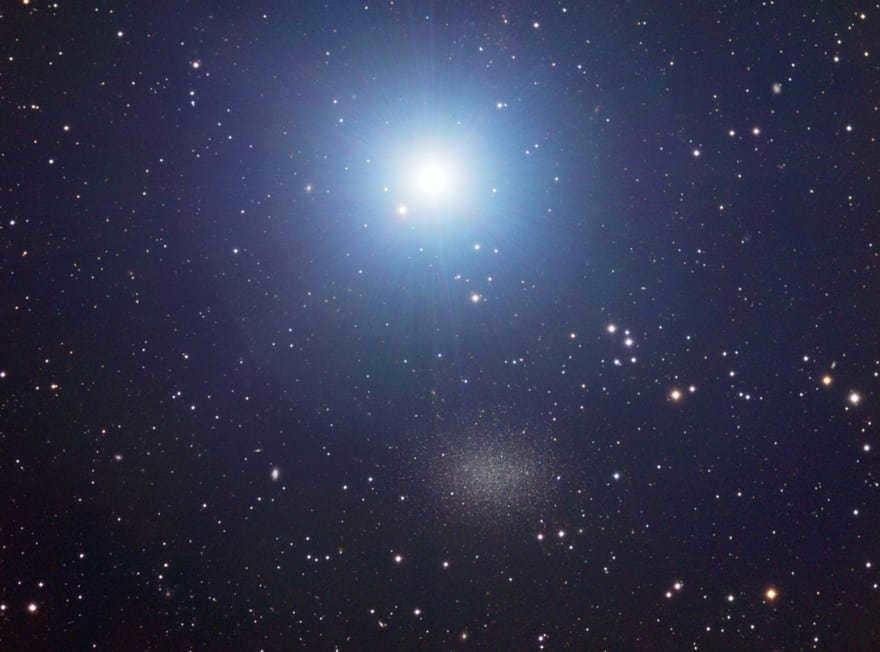
You can spot Regulus B using binoculars, but to catch a glimpse of C, you’ll need to invest in a powerful telescope. To make your search easier, take advantage of our online star map or explore a 3D model that showcases the movement of Regulus in space.
Regulus is visible year-round, except for August when the Sun gets too close to its apparent location. Its heliacal ascent occurs in the first week of September, and once every 8 years, Venus aligns with it. The best viewing time from the northern hemisphere is during winter and early spring.
Facts
Now it’s time to discover some fascinating details about the star Regulus. We will explore its vibrant color, precise coordinates, and intriguing facts that will surely captivate your interest.
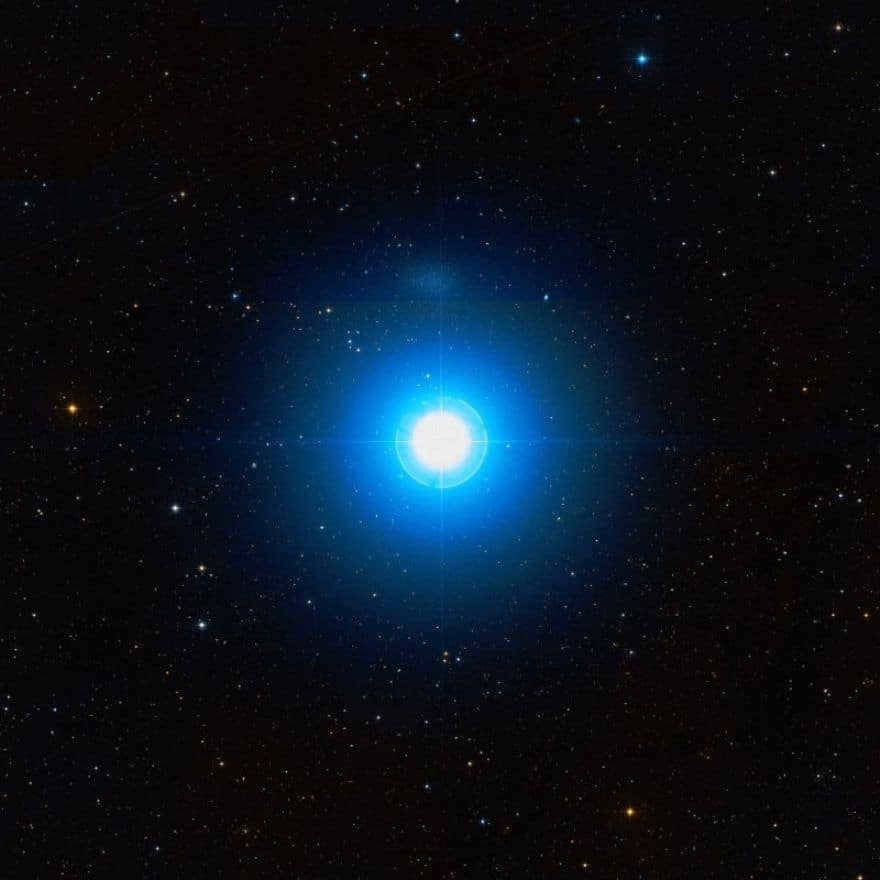
Regulus is positioned at a distance of 0.46 degrees from the ecliptic and is frequently crossed by the Moon. Its visibility is sometimes obstructed by Mercury and Venus. The last time Venus passed in front of the star was in 1959, and it will happen again in 2044.
Alpha Leo occasionally attracts asteroids towards itself. In 2014, the asteroid 163 Erigon (with a diameter of 73 km) approached the star from the asteroid belt. In 2005, the 54.6-kilometer wide asteroid 166 Rodol came close to Regulus.
Regulus, also known as Sharru in Babylon, Miyan to the Persians, and Magha in India, has a rich history and cultural significance. In the medieval period, it was considered one of the 15 fixed stars of Begen, believed to influence several planets.
The Regulus star system
The Regulus system is composed of four components, forming two pairs. The brighter component, Regulus A, is a spectroscopic double system consisting of a blue star and its white companion. These two stars have an orbital period of 40.11 days and are separated by a distance of 0.35 astronomical units (a.u.). Notably, the companion star was discovered in 2008, adding to our understanding of this fascinating star system.

